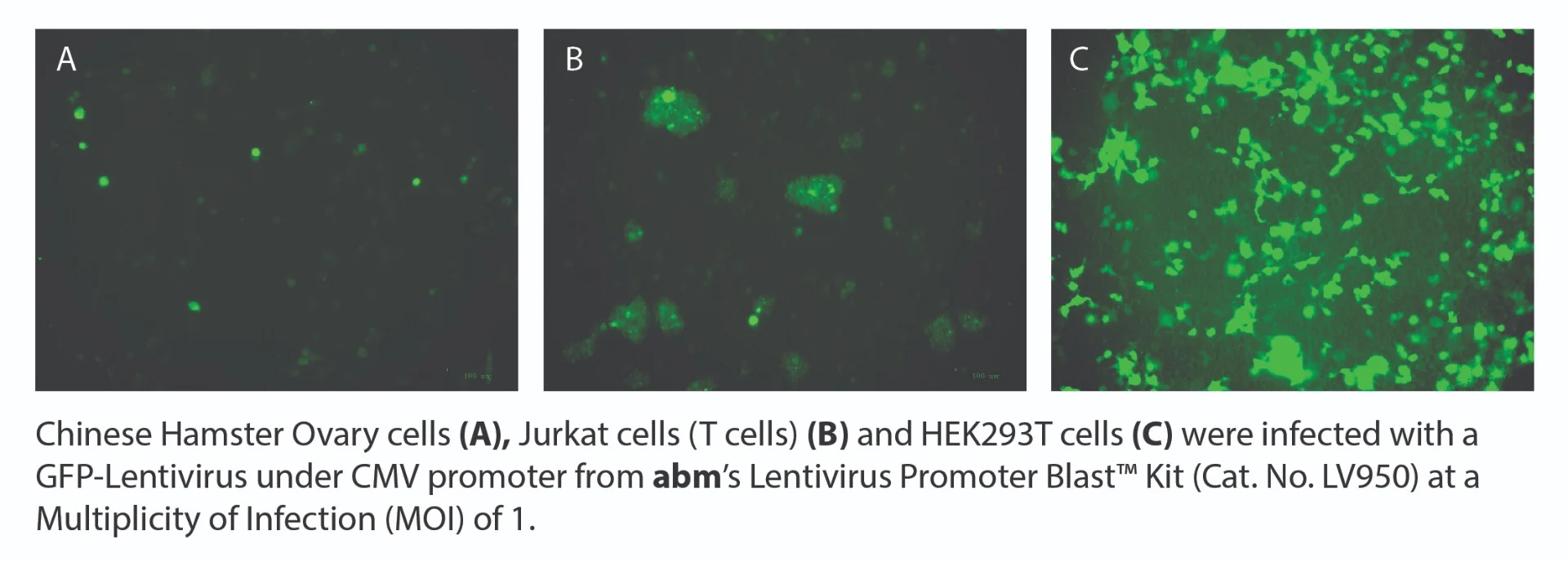Lentivirus Promoter Blast™ kit

|
Cat. No.
|
LV950 |
|---|---|
| Unit |
4 x 1ml
|
| Cat. No. | LV950 |
| Name | Lentivirus Promoter Blast™ kit |
| Unit | 4 x 1ml |
| Description | abm's Lentivirus Promoter Blast™ Kit is designed for easy monitoring and optimization of lentivirus transduction efficiency to help you achieve successful results in your stable cell line generation or engineering experiment. This kit includes 4 different GFP Lentiviruses (4 x 1ml at >1x106 IU/ml) with either the CMV, PGK, EF1α, or UBC promoter, enabling you to determine which promoter works best for your cell line. In addition, this kit can be used to calculate the optimal Multiplicity of Infection (MOI) for your transduction experiment - simply transduce your cells at various MOIs and monitor GFP signals!
Kit features:
After the optimal infection condition and promoter is identified, the lentivirus with your target gene and under your chosen promoter may be ordered separately either in low or high titer format. |
| Note | Infection Protocol
1. Plate the target cells in a 24-well plate, 24 hours prior to viral infection at a density of 0.5×105 cells per well. Add 0.5 ml of complete optimal medium (with serum and antibiotics if required) and incubate the cells at 37°C with 5% CO2 overnight. Note: It is possible to use other plate formats for transduction. In this case, the amount of cells should be adjusted depending on the growth area of the well/plate. 2. Thaw the lentivirus from –80°C at room temperature. We strongly suggest to make usable aliquots of lentivirus to avoid free-thaw since that is known to reduce the viral titer.Calculate the appropriate volume of virus needed to be diluted in media to achieve desired MOI. MOI= [(Product Titer (IU/ml) x Virus Volume (ml))/(Total Cell Number)]. Read more about Multiplicity of Infection (MOI) at our learning resources center. 3. Prepare a mixture of complete media with polybrene at a concentration of 8 μg/ml. Remove the growth media from the wells and replace with 0.5 ml of the polybrene-media-mix per well (add in ViralPlus Transduction Enhancer (Cat. No. G515) at 1:100 or at your own optimized dilution ratio). 4. Once an effective MOI has been determined for the target cells through preliminary test infections, use the appropriate volume of virus to infect your cells. Leave one well of uninfected cells as an additional standard control. Following the infection, incubate the cells at 37°C with 5% CO2 overnight. 5. The optimal MOI for the lentivirus can range from 1-100 depending on promoter and cell types and we suggest an MOI ranging from 0.5-5 as a starting point. |
What are the correct concentration units for each recombinant viral particle?
For lentiviruses and retroviruses, they are measured in CFU/ml (colony-forming units per millilitre). Transduction with lentiviruses and retroviruses can cause the formation of colonies, which can be quantified for concentration. For AAV the titer is measured as genome copies per mL (GC/mL). Adenoviruses are measured as PFU/ml (plaque-forming units per millilitre). Transduction with adenoviruses will kill packaging cells, forming plaques in the process for quantification. The concentration for all three types of viruses can also be classified as IU/ml (Infectious Units/ml). Ultimately, the units refers to the viral particles and different units reflect the different assays involved.
What do I use to check if my cells were successfully immortalized by the SV40 agent?
We have an SV40 T antibody that can be used for the western blot analysis. The catalog number is G202. Otherwise, a qPCR primer can be designed on the SV40 gene for qPCR analysis. The sequence can be found in the link below: http://www.abmgood.com/pLenti%20SV40-Vector-Location-Map.html
What are the primers to use for SV40 identification?
SV40 Forward Primer Sequence 5’ ACTGAGGGGCCTGAAATGA SV40 Reverse Primer Sequence 5’ GACTCAGGGCATGAAACAGG These are qPCR primers and the band size is 61 bp.
What advantages / disadvantages exist between the Lenti-SV40, -SV40T, and SV40T+t vectors?
There are simply differences in the content of all vectors due to customer demand for variety. Lenti-SV40 will contain the whole SV40 gene, -SV40T, the large T Antigen only, and -SV40T&t the large and small T antigens only. It is up to the end user to decide which vectors will best suit their project, however we have successfully used Lenti-SV40 (whole gene) in a wide range of immortalization projects.
What is the accession number for the SV40?
The SV40 covers the entire genome and the accession number is J02400.1. You can use this information to design primers for conventional PCR as well.
How long after transduction can the infection efficiency be observed?
You can observe transduction efficiency from 48 hours up to 5 days after infection.
What are the primers to use for SV40T and SV40T tsA58 detection?
PCR primers: SV40T Forward Primer Sequence 5’ AGCCTGTAGAACCAAACATT 3' SV40T Reverse Primer Sequence 5’ CTGCTGACTCTCAACATTCT 3' The two primers should amplify the region between 3677-4468bp, giving a 792bp fragment.
What is the sequence of the SV40 large T antigen?
This information can be accessed on this page by clicking on "pLenti-SV40-T" under vector map. The Large T antigen is at position 5079-5927.
For G221 and LV620, what does the 'V12' in RasV12 mean?
The V12 means that amino acid # 12 is mutated from a Valine to a Glycine. Other than that, the sequence matches the coding region of HRAS perfectly (NM_005343).
Where is the SV40T tsA58 gene sequence?
The SV40T tsA58 gene is located between 3138-5264bp, with the Alanine-to-Valine mutation at amino acid 438.
- Xia, et al. "High levels of protein expression using different mammalian CMV promoters in several cell lines" Protein expression and Purification. 45(1):115-124 (2006).
- Wang, et al. "Impact of different promoters, promoter mutation, and an enhancer on recombinant protein expression in CHO cells" Scientific Reports : (2017).
This product has no review yet.
Controls and Related Product:


